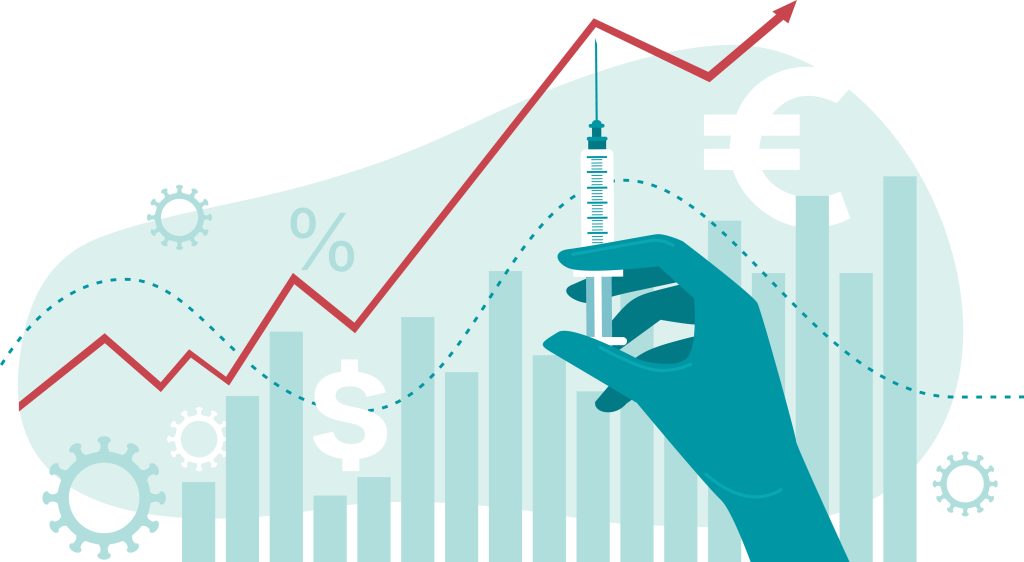As we begin 2022, the market is experiencing several underlying themes:
Covid-19 has Unbalanced the Global Supply and Demand for Goods
We have seen an increase in demand through highly accommodative monetary and fiscal policy putting more money into people’s pockets and consumer purchasing habits moving into goods over services because of continued shutdowns. On the supply side, global supply chains have been disrupted through labour shortages, as well as other factors, decreasing the amount of goods available. Exacerbated by increased commodity prices, levels of inflation across the world have entered territories not seen in decades. In December 2021, the US inflation rate accelerated to 7%, whereas Canada’s rose to 4.8% well above Central Bank targets of 1-3%. This has forced Central Banks to act swiftly to bring supply and demand back into balance and reduce inflation. This is accomplished by reversing the highly accommodative policies they implemented during the initial stages of the pandemic: increasing interest rates and slowly reducing their bond purchasing. Due to the economic impact of Covid-19, global GDP rates are expected to remain positive but slow down in 2022, which includes a reality that China’s economy continues to be at risk of a recession.

Russian Troops are Inching Towards the Ukraine Boarder
This has put the US on alert and created uncertainty about a potential major arms conflict, which could further increase oil prices, exacerbate inflation, and threaten global economic growth.
Company Valuations are High
We are coming off a large upswing in the stock market through 2021, caused by highly accommodative Central Bank policies. This has caused valuation multiples to increase substantially and speculation to reach heated levels, leading to price bubbles in certain parts of the market, especially in pandemic related “stay at home” stocks.
The above three themes have presented markets with a new batch of uncertainty…and we all know markets don’t like uncertainty. It causes a “price discovery,” as investors don’t know exactly how to value assets based on a lack of clarity for how companies will be impacted. This leads to volatility. With interest rate changes on the horizon, companies with high stock valuations, whose earnings have not yet materialized (valuations being based on their future expected earnings), are being most impacted. This is because of the “discount rate” increasing, which implies the difference between what a dollar is worth today and what it is worth at a future point in time (i.e when earnings are expected to materialize). There is also an expected increase in company cost of capital through higher lending rates on their debt, and the reduced probability that their earnings will materialize the way previously thought, based on the increase of unknown economic variables.

Stocks remain a good long term investment as long as we don’t see a recession. The good news is, that risk in North America is still very low. The US and Canada are both in the mid-cycle growth phase of the business cycle. Leading economic indicators such as: credit spreads, yield curve indications, Central Bank outlook, employment metrics (ie. job vacancies are elevated, hiring intentions are strong, and wage gains are picking up), and manufacturing and ordering levels for goods, remain elevated as well as significantly above where they were in lead ups to past recessions. The only major looming risk is Central Banks reversing their monetary policy too aggressively, but they are aware of this and seem to be taking a very methodical and transparent approach.
Historically, there is a pattern where the time leading up to interest rate increases tend to bring market volatility that fades after the first hike has been made. This suggests that the speculation of rising interest rates end up having a worse effect than the increases themselves. As the pandemic begins to fade in 2022 (and becomes more of an endemic), supply chains normalize, economies re-open, and the effects of Central Bank policies become more known, we should begin to see stability and continued positive returns for stocks, although likely more muted than those seen in 2021.
Now is a good time to emphasize the benefits of diversification and holding quality companies in your investment portfolio. Diversification of sector and geographical exposure reduce the correlation of your portfolio holdings. Companies with strong balance sheets, cash flow, earnings, history of increasing and sustainable dividends, a wide moat, and that don’t carry high valuations based on expected future results, are best able to weather times of uncertainty. This will give you peace of mind knowing that they are likely to return to and exceed their previous prices in the long term, even if the coming economic outlook isn’t as favorable. Our model portfolios are made up of these holdings and we continue to believe in the resilience of them beyond the short-term market noise.

I obtained my Economics Degree from the University of Calgary and have over 10 years of experience as an investment and lending advisor with one of the Big 5 banks in Canada. In 2018, I obtained the Chartered Financial Analyst (CFA®) designation, the premiere investment analysis distinction in the financial services industry. My academic knowledge, along with my experience and insights into the banking system and capital markets help make sure I put my clients savings to work and have them financially prepared to meet all of life’s goals and milestones. I am passionate about making sure my clients receive the industry’s best in financial advice and attention.
In my spare time I enjoy performing martial arts as well as skiing, making music, and soaking up new experiences with friends and family.


Recent Comments